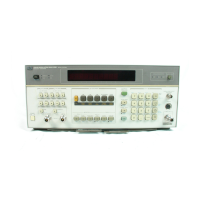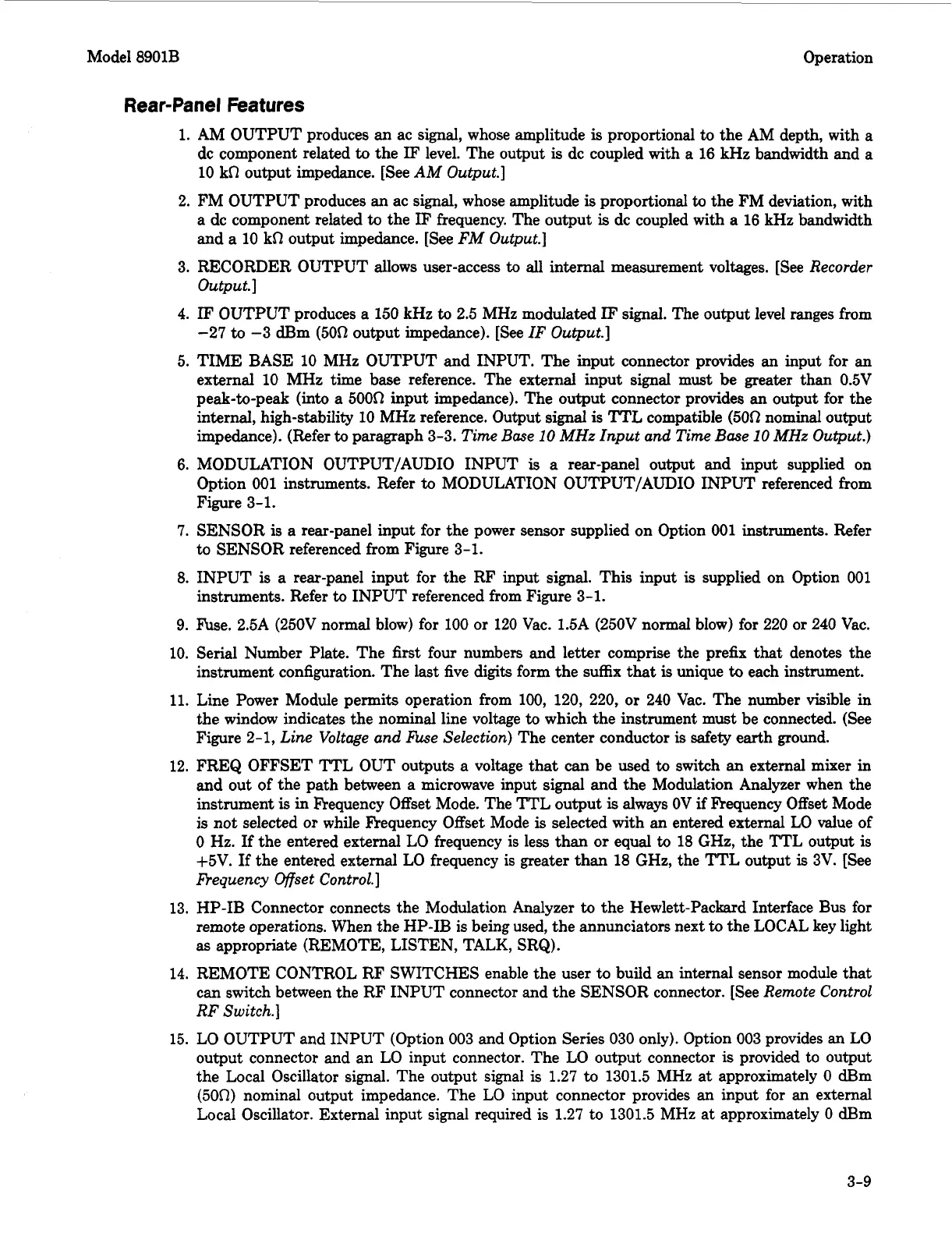Model 8901B
Rear-Panel Features
Operation
1.
2.
3.
4.
5.
6.
7.
8.
9.
10.
11.
12.
13.
14.
15.
AM OUTPUT produces an ac signal, whose amplitude
is
proportional to the AM depth, with a
dc component related
to
the
IF
level. The output
is
dc coupled with a 16
kHz
bandwidth and a
10 kR output impedance. [See
AM Output.]
FM OUTPUT produces an ac signal, whose amplitude
is
proportional
to
the FM deviation, with
a dc component related
to
the
IF
frequency. The output
is
dc coupled with
a
16 kHz bandwidth
and
a
10 kR output impedance. [See
FM Output.]
RECORDER OUTPUT allows user-access
to
all internal measurement voltages.
[See
Recorder
IF
OUTPUT produces a 150 kHz
to
2.5 MHz modulated
IF
signal.
The output level ranges from
-27
to
-3 dBm (500 output impedance). [See
IF Output.]
TIME BASE 10 MHz OUTPUT and INPUT. The input connector provides an input for an
external 10 MHz time base reference. The external input signal must be greater than 0.5V
peak-to-peak (into a
500n
input impedance). The output connector provides an output for the
internal, high-stability
10
MHz reference. Output signal
is
TTL
compatible
(500
nominal output
impedance). (Refer
to
paragraph 3-3.
Time
Base
10
MHz Input and Time Base
10
MHz Output.)
MODULATION OUTPUT/AUDIO INPUT
is
a
rear-panel output and input supplied on
Option 001 instruments. Refer
to
MODULATION OUTPUT/AUDIO INPUT referenced from
Figure 3-1.
SENSOR
is
a rear-panel input for the power sensor supplied on Option
001
instruments. Refer
to SENSOR referenced from Figure 3-1.
INPUT
is
a rear-panel input for the RF input
signal.
This input
is
supplied on Option 001
instruments. Refer
to
INPUT referenced from Figure 3-1.
F’use. 2.5A (250V normal blow) for 100 or 120 Vac.
1.5A
(250V normal blow) for 220
or
240 Vac.
Serial Number Plate. The
first
four numbers and letter comprise the prefix
that
denotes the
instrument configuration. The last five digits form the suffix
that
is
unique
to
each instrument.
Line Power Module permits operation from 100, 120, 220, or 240 Vac. The number visible in
the window indicates the nominal line voltage
to
which the instrument must be connected. (See
Figure 2-1,
Line Voltage and he Selection)
The center conductor
is
safety earth ground.
FREQ OFFSET TTL OUT outputs
a
voltage that can be used
to
switch
an
external mixer in
and out of the path between a microwave input signal and the Modulation Analyzer when the
instrument
is
in Frequency Offset Mode. The TTL output
is
always
OV
if
Frequency Offset Mode
is
not selected
or
while Frequency Offset Mode
is
selected with an entered external LO value of
0
Hz. If the entered external LO frequency is less than or equal
to
18 GHz, the TTL output is
+5V.
If
the entered external LO frequency is greater than
18
GHz, the TTL output
is
3V. [See
Bequency offset Control.]
HP-IB Connector connects the Modulation Analyzer
to
the Hewlett-Packard Interface Bus for
remote operations. When the HP-IB is being used, the annunciators next
to
the LOCAL key light
as appropriate (REMOTE, LISTEN, TALK, SRQ).
REMOTE CONTROL RF SWITCHES enable the user
to
build an internal sensor module that
can switch between the RF INPUT connector and the SENSOR connector. [See
Remote Control
RF Switch.]
LO OUTPUT and INPUT (Option 003 and Option Series 030 only). Option 003 provides an
LO
output connector and an LO input connector. The LO output connector
is
provided to output
the Local Oscillator
signal.
The output signal is 1.27
to
1301.5 MHz at approximately
0
dBm
(50R) nominal output impedance. The LO input connector provides an input for an external
Local Oscillator. External input signal required
is
1.27 to 1301.5 MHz at approximately
0
dBm
Output.]
3-9

